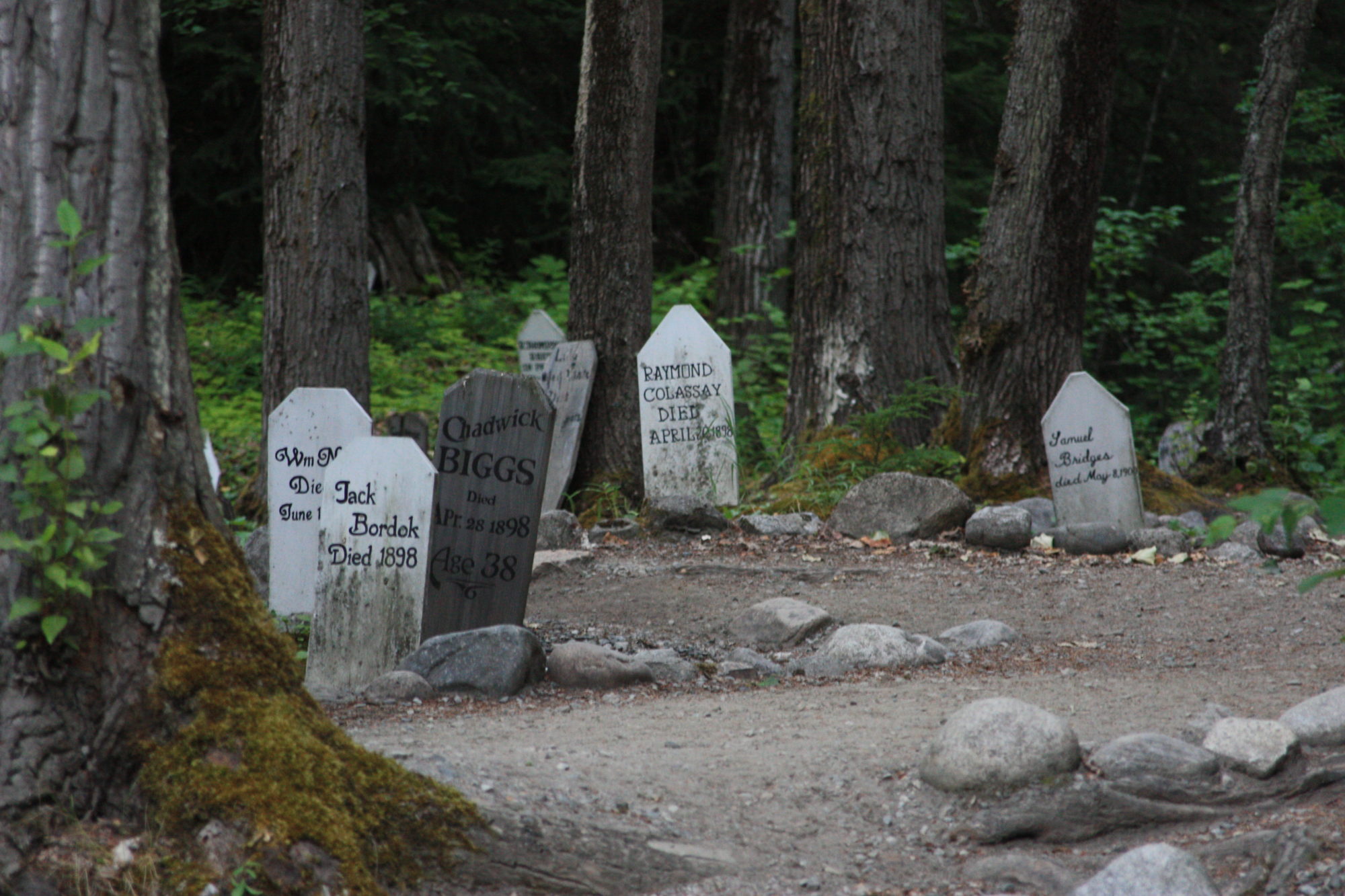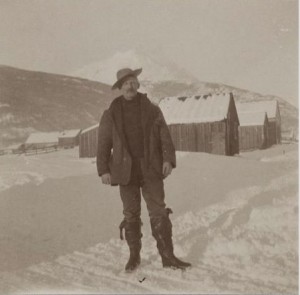 I call this blind faith, but really, would you cross this crevasse on this snow bridge? This was taken in 1947 at Mt. McKinley.
I call this blind faith, but really, would you cross this crevasse on this snow bridge? This was taken in 1947 at Mt. McKinley.
The Annual Bear Shoot
Two mornings ago I was walking to the gym at 5:30 am. It was dark and I was looking at the stars….suddenly a bear charged me . It was a terrifying experience, I screamed, stumbled and fell, then got up and screamed some more. I focused on the 3-inch yellow claws but it was dark enough that I could not see its face, but I did see another bear behind it. I believe it was a Grizzly sow with cub and she had been eating garbage that was put out the night before. I unfortunately walked within a few feet of them and startled them which is why she charged me. She then turned and walked away.
<p>
It was a perfectly predictable behavior on the part of the bear. I hold no anger against her but only sadness that eventually she and the cub will be shot as many others have been each fall. At this time of year they are trying to fatten up before winter and garbage is an easy food source. The tragedy is that if this little community would invest in bear proof garbage cans for everyone, the problem would be greatly remedied. I have had many people tell me that they are glad I am alive and that I am brave. I only acted as anyone would, but I am grateful for the attention that this event has brought to our need for community action. I believe that our community has many good hearted people who would agree that the one time expense of buying the downtown households bear proof trash cans would be worth the cost and effort.
Robert Kennicott
Robert Kennicott was born in New Orleans on November 13, 1835. In April 1859, supported by the Smithsonian Institution, the Audubon Society of Chicago, and the Hudson’s Bay Company, he set off on an expedition to collect natural history specimens in the subarctic boreal forests of northwestern Canada in what is now the Mackenzie and Yukon river valleys and in the Arctic tundra beyond. Hudson’s Bay Company fur traders in the area liked him and so Kennicott encouraged them to collect and send natural history specimens and First Nations artifacts to the Smithsonian. He returned to Washington at the end on 1862. With the Civil War in full play in 1862-64, Robert and his younger brother lived in the Smithsonian Castle along with Edward Drinker Cope and other noted naturalists.
He traveled across the Unalakleet portage to Nulato over the winter of 1865-1866 with Charles Pease and 2 Canadians, Frank Ketchum and Michael Lebarge.
In 1866, Kennicott failed to reach Fort Yukon, where he expected to meet another party from the Frazer River. One story says that this failure so preyed on his mind that he took a dose of strychnine. Other reports state that he died of a heart attack, but in any event we know he died on May 13, 1866. His remains were returned to the Kennicott Family plot in Glenview, Illinois at The Grove, which is a National Historic Landmark.
To commemorate his efforts on behalf of science, the Kennicott Glacier, Kennicott Valley, Motor Vessel Kennicott, and the Kennicott River were named after him.
Alaska and its Resources by William Healey Dall; The Dyea Trail January 19, 1898; Wikipedia.
Bargain Cruise
AYP Exposition Seattle

Here is a photo of the AYP in 1909 which opened with 80,000 visitors.
Brothers John and Frederick Olmstead, designed the fairgrounds. The central portion of the grounds was oriented along axes that exploited the natural beauty of the setting, with views of Mount Rainer, Lake Union and Lake Washington. Built on 250 acres of the largely undeveloped campus of the University of Washington (and partially funded by the state legislature for later use by the University), the AYPE grounds were close to downtown and convenient transportation. Though most of the buildings, designed by John Galen Howard, were too poorly built to survive, the landscaping of the grounds added value to the university by removing wilderness and opening new possibilities for future university installations.
The grounds were centered around the Arctic Circle, with its cascading fountain and reflecting pool, and the surrounding Court of Honor, flanked by two wings of three buildings on either side. Descending from the domed Government Building, these six building were named for Europe, Asia, Alaska, Hawaii and the industries of Manufacturing and Agriculture. Among other notable AYPE buildings was the Forestry Building, a massive structure built entirely of huge logs in their natural state and surviving for several years after the Exposition as the Washington State Museum, until it was damaged by beetles and razed in 1931.
Heywood Walter Seton-Karr

Mr. Seton-Karr was born on this day, June 2, 1859 in Belgaum, India. He became a famous artist, explorer and “archaeologist” and came to the great Northwest in 1886. He kept a wonderful diary in which he sketched scenes such as the one above of Lynn Canal. It looks like Skagway with the jagged peaks behind.
Seton-Karr “discovered” the Altsehk or Dalton Pass near Haines. He died in 1938 in Paddington, England.
The Alaskan of June 28, 1890; Alaska State Archives.
An uncommon silence
Mt Blackburn about 10 miles from the base of Muir Glacier apparently “erupted” on April 10, 1902. A geologist, J.C. McFarland who happened to be nearby stated:
“On April 11 at about 7:30 in the morning the air about me became oppressive with a distinct and uncommon silence. In my wanderings through different wilds I had become used to many strange freaks of nature, but this one appalled me. I was in a rough mountainous country, I should judge about 10 miles from the base of Mount Blackburn, in Southeastern Alaska, not far from the starting point of a glacier called Muir Glacier. Suddenly the earth beneath my foot shook, a low rumbling sound accompanied the quaking. I glanced up at Mount Blackburn. Instantly it seemed as though the peak had opened; a cloud of ashes and smoke shot out into the air several hundred feet, and then there seemed to flow from the opening in the top a stream of dirty stuff mixed with large and small boulders. This continued only for about ten minutes then ceased as suddenly as it had begun.
It was three days after many perilous attempts before I succeeded in reaching the base of the mountain. Then I discovered that the country for miles around had been affected. The small undergrowth of the trees had been entirely covered. This stuff which poured from the top of the mountain was not even warm, but seemed to consist purely of dust rocks and other substances. As far as I can discover this mountain had never been considered of a volcanic nature.”
The official story is that the last time Mt Blackburn erupted was 3-5 million years ago. The 1902 incident was probably just a geologic burp.
New York Times, June 3, 1902
Tsunami watch
Charles Augustus Sehlbrede
Reverend Gus (he was also a minister) came to Skagway in 1898 from Oregon.
Born on this day, December 10, 1851 in Louisville, Kentucky, Gus was one of ten children. After college, he took the train to Oregon in 1877 and passed the Oregon Bar the next year. He married in 1883 in Salem, Oregon.
Because of the recommendation of U. S. Senator George W. McBride, Sehlbrede was appointed as U. S. Commissioner at Skagway, Alaska by President McKinley. While on that appointment, he presided over the coroner’s inquest for Soapy Smith. He was also appointed town recorder after John U. Smith left. (Smith was a crooked U.S. commissioner for Dyea from August 1897 to May 1898 who disappeared the night that Soapy was shot.)
Sehlbrede brought his wife, Ianthe, and his two daughters, Bertha Lucille and Emma Lucrecia to Skagway. However, Ianthe and daughters left in 1901 to go back Corvallis (wimps). Judge Sehlbrede joined them soon after in sunny Oregon.
The photo above is from a 1947 magazine article.
Sehlbrede died in 1922 in Corvallis also and is buried in Oak Lawn Memorial Park there.
1900 census;Pioneer History of Douglas County, Oregon; Pennington; 1902 directory;Portrait and Biographical Record of Western Oregon, published by Chapman Publishing Company, Chicago. 1904
Thomas Christmas Riggs Jr.

Happy Birthday to Thomas Riggs, third governor of Alaska. Riggs was born on this day, October 17, in 1873 in Ilchester, Maryland. He attended good schools and graduated from Princeton in civil engineering in 1894. The Riggs family moved to Washington state and was involved in the lumber business. Thomas came to Skagway in 1897, joined the Arctic Brotherhood, was a U.S. Surveyor, and owned the Dyea Lumber Company. Hmmm, no conflict of interest there.
He then unseccessfully prospected for gold in Dawson and Nome before heading south to Idaho. He found politics more rewarding presumably and was appointed to the U.S. Boundary Commission in 1903 and soon become the United States Engineer-in-Charge. During this effort, his team surveyed the United States-Canada boundary from the Pacific to Arctic Oceans, placed boundary markers, and cleared wooded areas to provide a clear line of sight between markers. (What became of the lumber I wonder?)
After that, President Wilson appointed him to the Alaska Railroad Commission during which time he oversaw the building the Alaska Railroad. President Wilson then appointed him the third Governor of Alaska in 1918.
During his governorship he saw the 1918 flu epidemic arrive in Alaska and made efforts to stop it, but to no avail. The flu wiped out entire villages and left hundreds of native orphans.
When Harding was elected President, Riggs left the governorship and Governor Bone was appointed. Riggs then left Alaska and moved to New York and finally Washington D.C. where he died in 1945 at the age of 72.
Wikipedia; NPS records; WW1 Registration; 1909 Arctic Brotherhood membership book. Below is a picture of him in Dyea (picture from an ebay posting)






